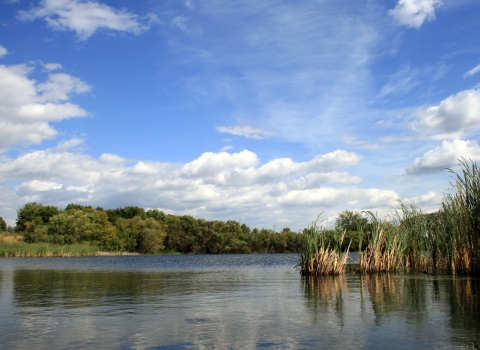Parker River National Wildlife Refuge opened a 30-day public comment period on a draft Environmental Assessment (EA) that includes a proposal to demolish the house at 60 Plum Island Turnpike in Newbury, MA, commonly known at the Pink House, and to restore the property. The comment period ran from November 1 - November 30, 2023.
In response to community feedback, refuge staff have worked diligently with partners to locate a suitable land exchange parcel to save the house from demolition. After an exhaustive search spanning more than seven years, no viable exchange parcels were ultimately located. An open letter to community regarding the process can be read online here.
Originally constructed in 1925, the Pink House is known to contain materials harmful to human health, including asbestos. The nearly 100-year-old structure structure
Something temporarily or permanently constructed, built, or placed; and constructed of natural or manufactured parts including, but not limited to, a building, shed, cabin, porch, bridge, walkway, stair steps, sign, landing, platform, dock, rack, fence, telecommunication device, antennae, fish cleaning table, satellite dish/mount, or well head.
Learn more about structure requires frequent maintenance – using taxpayer funds – to prevent catastrophic damage. Additionally, the property floods routinely during storm events, and sea level rise projections indicate increased frequency and intensity of roadway flooding in this area.
The EA also proposes opening the property to the public for wildlife observation and interpretation for the first time ever if the house is removed. An accessible observation platform would be constructed, providing an elevated position where all visitors can appreciate the natural beauty and learn about the ecology of the Great Marsh.
Frequently Asked Questions
What is the timeline for this Environmental Assessment?
Staff are currently reviewing all public comments submitted between November 1-30, 2023. It will likely take at least 1 month to analyze comments, draft responses, and edit the plan before a final draft is published some time in the New Year. While the public comment period has ended, anyone with potentially viable land exchange opportunities may still reach out to refuge staff at parkerriver@fws.gov (see below and this page for specific land exchange criteria).
What is the Pink House?
Constructed in 1925, the Pink House is a 3-bedroom, two story former private residence situated along Plum Island Turnpike in Newbury, MA. It is surrounded by the turnpike to the north and salt marsh salt marsh
Salt marshes are found in tidal areas near the coast, where freshwater mixes with saltwater.
Learn more about salt marsh and tidal creek in all other directions.
Why and when did the Service acquire the Pink House?
The US Fish and Wildlife Service (hereafter, ‘Service’) purchased the Pink House — along with more than nine acres of upland, salt marsh and tidal creek habitat — in 2011 to permanently protect the property and its sensitive habitats from development and to evaluate whether the house could be used for seasonal staff housing.
Why does the Service propose to remove the Pink House?
In 2014, a preliminary environmental survey of the building found that it contains asbestos, a serious human health risk. The property was also in a state of disrepair when purchased, and deterioration has continued since. Given these health and safety hazards, the Service determined that the building is not suitable as housing for seasonal staff, nor does it have any other feasible use for the refuge.
Further, the property has become an attractive nuisance, requiring frequent law enforcement patrols and repair work due to vandalism. Service maintenance staff and funds are increasingly required to maintain structural stability and safety. The house has a permanently flooded basement, is within an active flood zone, and recent sea level rise predictions indicate flooding will be even more severe in the years to come. Demolition and removal are therefore in the best interest of public safety, taxpayer money, and the environmental health of the area.
What has the Service done to save the house from demolition?
In response to community members, the Service has worked diligently with landowners, elected officials, and local advocacy groups for more than seven years to find an equal-value land exchange. While several promising leads were pursued, none were ultimately successful. In the interest of safety, and to ensure the house remained intact to affect an exchange, staff maintained the house to prevent catastrophic damage. For reasons outlined above, this approach is no longer feasible. Scenarios explored over the past seven years include:
Could the Service sell or donate the Pink House property?
No. The Service has limited authority to sell or donate the land it administers as defined in the Federal Land Policy and Management Act of 1976. Because the surrounding habitat is of high ecological value and supports the refuge’s mission, only an equal-value (i.e., $400,000-$500,000) land exchange is applicable. Potentially suitable properties include those contiguous (preferred) or within 1 mile of refuge boundaries with salt marsh and/or adjacent upland habitats.
Could the Pink House be repurposed for use by the Service or the public?
No, due to the refuge’s core mission to protect wildlife and their habitats, in addition to health and safety hazards within the structure, the Pink House is not suitable for use by Service employees or members of the public.
Could the Pink House be relocated?
Yes, a private buyer could purchase the house from the Service and relocate it. The Service cannot pay to relocate the Pink House. If a serious offer were made during the comment period and an agreement were reached in a timely manner, relocation could be pursued.
Could the Pink House be restored by volunteers or private contractors at their own expense?
Health and safety hazards within the Pink House prevent the Service from accepting volunteer restoration work due to risk of serious injury to volunteers and/or Service staff. Further, federal law stipulates that contracted construction work undergo a competitive bidding process and adhere to federal wage and labor standards.
Is the Pink House listed on the National Register of Historic Places?
No. In 2011, the Massachusetts Historical Commission determined that the house does not meet the criteria for listing on the National Register of Historic Places and is therefore ineligible.
What will happen to the property if the Pink House is removed?
Removal of the Pink House would create an opportunity to enhance both the future resiliency and public access opportunities of this area. This would include providing a small parking area on the existing footprint of the driveway and constructing an accessible, low-profile viewing area. An area that has long been closed to public access would afford a unique opportunity for people of all abilities to experience and learn about the Great Marsh ecosystem from a unique vantage point.



